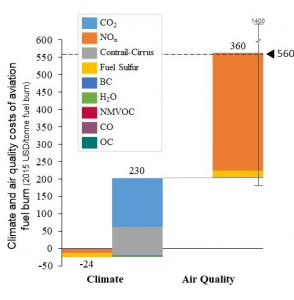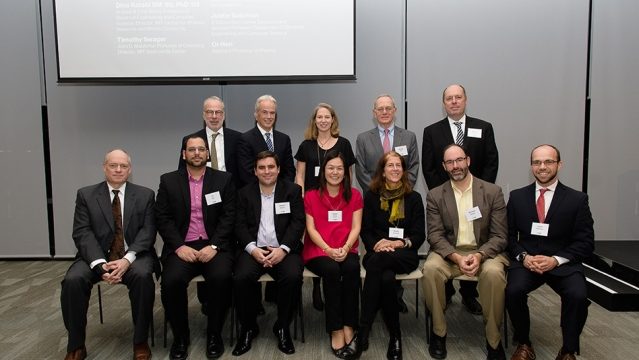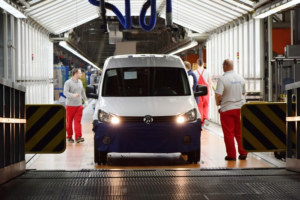Category: Uncategorized
LAE researchers collaborating with Delta to prevent persistent contrails

MIT researchers in the Department of Aeronautics and Astronautics Laboratory for Aviation and the Environment partner with Delta to prevent the climate warming effect of contrails. The focus of the study is how to eliminate persistent contrails, which make up about 10% of all contrails and which create clouds that trap heat and warm the earth, according to Delta. For more information on the collaboration, see Delta’s news release.
Half of air pollution in the U.S. to come from out-of-state emissions

More than half of all air quality-related early deaths in the United States are a result of emissions that originate outside of the state in which those deaths occur, LAE researchers report today in the journal Nature.
The study focuses on the years between 2005 and 2018 and tracks combustion emissions of various polluting compounds from various sectors, looking at every state in the contiguous United States, from season to season and year to year.
The researchers find that while air pollution may be generated in one state, half of that pollution is lofted into the air and carried by winds across state boundaries, to affect the health quality of out-of-state residents and increase their risk of early death.
Electric power generation is the greatest contributor to out-of-state pollution-related deaths, the findings suggest. In 2005, for example, deaths caused by sulfur dioxide emitted by power plant smokestacks occurred in another state in more than 75 percent of cases.
Encouragingly, the researchers found that since 2005, early deaths associated with air pollution have gone down significantly. They documented a decrease of 30 percent in 2018 compared to 2005, equivalent to about 30,000 avoided early deaths, or people who did not die early as a result of pollution. In addition, the fraction of deaths that occur due to emissions in other states is falling — from 53 percent in 2005 to 41 percent in 2018.
Perhaps surprisingly, this reduction in cross-state pollution also appears to be related to electric power generation: In recent years, regulations such as the Environmental Protection Agency’s Clean Air Act and other changes have helped to significantly curb emissions from this sector across the country.
The researchers caution, however, that today, emissions from other sectors such as commercial and residental are increasingly contributing to harmful cross-state pollution.
“Regulators in the U.S. have done a pretty good job of hitting the most important thing first, which is power generation, by reducing sulfur dioxide emissions drastically, and there’s been a huge improvement, as we see in the results,” says study leader Steven Barrett, the Director of the MIT Laboratory for Aviation and the Environment. “Now it’s looking like other emissions sectors are becoming important. To make further progress, we should start focusing on road transportation and commercial and residential emissions.”
Barrett’s coauthors on the paper are MIT research scientist Sebastian Eastham, former MIT graduate student and now TU Delft assistant professor Irene Dedoussi, and former MIT research scientist Erwan Monier, now an assistant professor at UC Davis. The research was a collaboration between MIT’s Laboratory for Aviation and the Environment, and the MIT Joint Program on the Science and Policy of Global Change.

Death and the matrix
Scientists have long known that pollution observes no boundaries, one of the prime examples being acid rain.
“It’s been known in Europe for over 30 years that power stations in England would create acid rain that would affect vegetation in Norway, but there’s not been a systematic way to capture how that translates to human health effects,” Barrett says.
In the case of the United States, tracking how pollution from one state affects another state has historically been tricky and computationally difficult, Barrett says, because of the “sheer number of states” — 48 contiguous states, each of which researchers would have to track emissions to and from the rest of the 47 states.
“But now there are modern computational tools that enable us to do these assessments in a much more efficient way,” Barrett says. “That wasn’t really possible before.”
He and his colleagues developed such tools, drawing on fundemental work by Daven Henze at UC Boulder, to track how every state in the contiguous U.S. affects pollution and health outcomes in every other state, for multiple species of pollutants such as sulfur dioxide, ozone, and fine particulates, and from various emissions sectors including electric power generation, road transportation, marine, rail, and aviation, and commercial and residential sources, and for every hour of the year.
They first obtained emissions data from each of seven different sectors for the years 2005, 2011, and 2018. They then used the GEOS-Chem atmospheric chemistry transport model to track where these emissions ended up, from season to season and year to year, based on wind patterns and a pollutant’s chemical reactions to the atmosphere. Finally, they used an epidemiologically derived model to relate increases in a population’s exposure to pollutants, to their risk of early death.
“We have this multidimensional matrix that characterizes the impact of a state’s emissions of a given economic sector of a given pollutant at a given time, on any other state’s health outcomes,” Barrett says. “We can figure out, for example, how much NOx emissions from road transportation in Arizona in July affects human health in Texas, and do those calculations instantly.”

Importing pollution
The researchers also found that emissions traveling out of state could affect the health of residents beyond immediate, neighboring states.
“It’s not necessarily just the adjacent state, but states over 1,000 miles away that can be affected,” Barrett says, adding that “different kinds of emissions have a different kind of range.”
For example, electric power generation has the greatest range, as power plants can loft pollutants far into the atmosphere, allowing them to travel over long distances. In contrast, commercial and residential sectors generally emit pollutants that chemically do not last as long in the atmosphere. “The story is different for each pollutant,” Barrett says.
In general, the researchers found that out-of-state air pollution was associated with more than half of all pollution-related early deaths in the U.S. from 2005 to 2018.
In terms of the impact on individual states, the team found that many of the northern Midwest states such as Wyoming and North Dakota are “net exporters” of pollution, partly because the populations there are relatively low and the emissions these states generate are carried away by winds to other states. Those states that “import” health impacts tend to lie along the East Coast, in the path of the U.S. winds that sweep eastward.
New York in particular is what the researchers call “the biggest importer of air pollution deaths”; 60 percent of air pollution-related early deaths are from out-of-state emissions.
“There’s a big archive of data we’ve created from this project,” Barrett says. “We think there are a lot of things that policymakers can dig into, to chart a path to saving the most lives.”
This research was supported in part by the U.S. Environmental Protection Agency, the VoLo Foundation, the MIT Martin Family Fellowship for Sustainability, and the George and Marie Vergottis Fellowship at MIT.
Link to the publication: https://www.nature.com/articles/s41586-020-1983-8
Text by MIT Press Office.
New LAE study quantifies air quality and climate impacts of aviation

New research from MIT’s Laboratory for Aviation and the Environment has quantified the climate and air quality impacts of aviation, broken down by emission type, altitude and location. Writing in Environmental Research Letters, the research team examines how this damage can be mitigated, and provides consistent comparative assessments of aviation emissions trade-offs, considering both climate and air quality impacts.
Climate and air quality impacts
Dr Sebastian Eastham, one of the leading researchers on the project, said: “Aviation emissions are an increasingly significant contributor to anthropogenic climate change. They cause five per cent of global climate forcing. When you consider the full flight, which includes emissions from takeoff, cruise and landing, aircraft emissions are also responsible for around 16,000 premature deaths a year from impaired air quality. This is small compared to other sectors, being only around 0.4% of the total deaths attributed annually to global air quality degradation, but is often overlooked in policy analysis.”

Dr Eastham said: “Our results show three components are responsible for 97 per cent of climate and air quality damages per unit aviation fuel burn: air quality impacts of NOx at 58 per cent; climate impacts of CO2 at 25 per cent; and climate impacts of contrails at 14 per cent. It is important to note that the vast majority, around 86 per cent in fact, of the NOx impacts on air quality are due to the emissions from cruise as opposed to the landing and takeoff cycle. These components – cruise NOx emissions, CO2 emissions, and contrails – are therefore primary targets for future strategies to reduce the atmospheric impacts of aviation emissions.”
“We found the air quality impacts of aviation emissions significantly exceed the climate impacts, with air quality impacts being 1.7 to 4.4 times higher than the climate impact per unit of fuel burn. This must be contrasted to ground-based industries, where post-combustion emissions control and access to cleaner fuels is widespread. For example, the climate impacts of the US power sector are of similar magnitude as the air quality impacts following significant declines in co-pollutant emissions over the past 15 years. This points towards potential political and technological opportunities for reducing the atmospheric impacts of the aviation sector.”
Mitigation approaches
 Historically, attempts to address the climate and air quality impacts from aviation have been through changes in policy, technology, and/or operations – improvements to fuel efficiency; more stringent emissions standards; market-based measures to reduce CO2 emissions; or the introduction of sustainable aviation fuels.
Historically, attempts to address the climate and air quality impacts from aviation have been through changes in policy, technology, and/or operations – improvements to fuel efficiency; more stringent emissions standards; market-based measures to reduce CO2 emissions; or the introduction of sustainable aviation fuels.
The study notes that reducing one type of emission can come at the cost of increasing another, either in absolute terms or by limiting potential reductions offered by new technology. Dr Eastham explained: “Some studies have suggested that they could decrease NOx emissions by designing engines with lower pressure ratios and combustor temperatures. However, they find that the resulting loss in thermodynamic efficiency would mean that we need to burn more fuel, meaning more CO2. The impacts from these types of trade-offs need to be quantified, and our study offers a fast way for decision makers to do this. We developed a set of metrics for comparing the climate and air quality impacts of aviation emissions at all flights stages, by estimating the social costs per unit of emitted pollutant. The cost metrics are broken down by flight phase – cruise, landing and take-off – and by the geographical region of emission, both per kg of emission and per kg of fuel burn.”
The research team applied the metrics to evaluate the effects of a global expansion in aviation, consistent in magnitude with its current annual growth. They then used this as a benchmark for three scenarios.
First, they considered a growth scenario with fuel efficiency increases and reductions in NOx emissions factors consistent with 10-year goals. Second, they evaluated the trade-offs between the climate and air quality impacts of one type of engine-based NOx emissions reductions. Finally, they re-assessed the climate and air quality trade-offs of jet fuel desulfurisation.
The paper is available here.
Researchers host leading experts to discuss future of electric aircraft propulsion

MIT engineers fly first-ever plane with no moving parts

2,700 premature deaths attributed to excess emissions of Diesel cars

In September 2015, German Volkswagen Group, the world’s largest car producer, admitted to having installed “defeat devices” in 11 million diesel cars sold worldwide between 2008 and 2015. The devices enabled more than 11 million passenger vehicles to meet U.S. emissions standards in the laboratory despite producing emissions up to 40 times higher than the legal limit in real-world driving conditions.
Now a new MIT study reports that according to publicly available measurements, Volkswagen is not the only auto manufacturer to make diesel cars that produce vastly more emissions on the road than in laboratory tests. The study, published in Atmospheric Environment, finds that in Europe, 10 major auto manufacturers produced diesel cars, sold between 2000 and 2015, that were found to generate up to 16 times more emissions on the road than in regulatory tests — a level that exceeds European limits but does not violate any EU laws.
 The researchers predict these excess emissions will have a significant health impact, causing approximately 2,700 premature deaths per year across Europe. These health effects, they found, are “transboundary,” meaning that diesel emissions produced in one country can adversely affect populations in other countries, thousands of kilometers away.
The researchers predict these excess emissions will have a significant health impact, causing approximately 2,700 premature deaths per year across Europe. These health effects, they found, are “transboundary,” meaning that diesel emissions produced in one country can adversely affect populations in other countries, thousands of kilometers away.
“You might imagine that where the excess emissions occur is where people might die early,” says study author Steven Barrett, the Raymond L. Bisplinghoff Professor of Aeronautics and Astronautics at MIT. “But instead we find that 70 percent of the total [health] impacts are transboundary. It suggests coordination is needed not at the country, but at the continental scale, to try to solve this problem of excess emissions.”
The 10 manufacturers’ excess emissions may not be a result of “defeat devices”, as was the case with Volkswagen. Instead, the team writes that “permissive testing procedures at the EU level and defective emissions control strategies” may be to blame.
The researchers report a silver lining: If all 10 auto manufacturers were to improve their emissions control technologies to perform at the same level as the best manufacturer in the group, this would prevent up to 1,900 premature deaths per year.
“That’s pretty significant in terms of the number of premature mortalities that would be avoided,” Barrett says.
Barrett’s co-authors at MIT are Guillaume Chossière, Robert Malina (now at Hasselt University), Florian Allroggen, Sebastian Eastham, and Raymond Speth.
Tuning the knobs
The study focuses on emissions of nitrogen oxides, or NOx, a type of gas that is produced in diesel exhaust. When the gas gets oxidized and reacts with ammonia in the atmosphere, it forms fine particles and can travel for long distances before settling. When these particles are inhaled, they can lodge deep in the lungs, causing respiratory disease, asthma, and other pulmonary and cardiac conditions. Additionally NOx emissions cause the formation of ozone, a pollutant long associated with adverse health outcomes.
 “There are many times the number of diesel cars in Europe compared to the U.S., partly because the EU started pushing diesel for environmental reasons, as it produces less carbon dioxide emissions compared with [gasoline],” Barrett says. “It’s a case where diesel has probably been beneficial in terms of climate impacts, but it’s come at the cost of human health.”
“There are many times the number of diesel cars in Europe compared to the U.S., partly because the EU started pushing diesel for environmental reasons, as it produces less carbon dioxide emissions compared with [gasoline],” Barrett says. “It’s a case where diesel has probably been beneficial in terms of climate impacts, but it’s come at the cost of human health.”
Recently, the EU started tightening its standards for diesel exhaust to reduce NOx emissions and their associated health effects. However, independent investigations have found that most diesel cars on the road do not meet the new emissions standards in real driving conditions.
“Initially manufacturers were able to genuinely meet regulations, but more recently it seems they’ve almost tweaked knobs to meet the regulations on paper, even if in reality that’s not reproduced on the road,” Barrett says. “And that’s not been illegal in Europe.”
Life exposure

In this study, Barrett and his colleagues quantified the health impacts in Europe of excess NOx emissions — emissions that were not accounted for in standard vehicle testing but are produced in actual driving conditions. They also estimated specific manufacturers’ contributions to the total health impacts related to the excess emissions.
The researchers considered 10 major auto manufacturers of diesel cars sold in Europe, for which lab and on-road emissions data were available: Volkswagen, Renault, Peugeot-Citroën, Fiat, Ford, General Motors, BMW, Daimler, Toyota, and Hyundai. Together, these groups represent more than 90 percent of the total number of diesel cars sold between 2000 and 2015, in 28 member states of the EU, along with Norway and Switzerland.
For each manufacturer, the team calculated the total amount of excess emissions produced by that manufacturer’s diesel car models, based on available emissions data from laboratory testing and independent on-road tests. They found that overall, diesel cars produce up to 16 times more NOx emissions on the road than in lab tests.
They then calculated the excess emissions associated with each manufacturer’s diesel car, by accounting for the number of those cars that were sold between 2000 and 2015, for each country in which those cars were sold.
The team used GEOS-Chem, a chemistry transport model that simulates the circulation of chemicals and particles through the atmosphere, to track where each manufacturer’s excess NOx emissions traveled over time. They then overlaid a population map of the EU onto the atmospheric model to identify specific populations that were most at risk of exposure to the excess NOx emissions.
Finally, the team consulted epidemiological work to relate various populations’ NOx exposure to their estimated health risk. The researchers considered four main populations in these calculations: adults with ischemic heart disease, stroke, chronic obstructive pulmonary disease, and lung cancer.
Overall, they estimated that, each year, 2,700 people within these populations will lose at least a decade of their life due to exposure to excess NOx emissions from passenger cars. They broke this number down by manufacturer and found a wide spread of health impact contributions: Volkswagen, Renault, and General Motors produced diesel cars associated with the most yearly premature deaths, each numbering in the hundreds, while Toyota, Hyundai, and BMW were associated with fewer early deaths.
“The variation across manufacturers was more than a factor of five, which was much bigger than we expected,” Barrett says.
“There’s no safe level”
For each country, the team also compared the excess emissions that it produced itself, versus the number of premature deaths that its population incurred, and found virtually no relationship. That is, some countries, such as Poland and Switzerland, produced very little NOx emissions and yet experienced a disproportionate number of premature deaths from excess emissions originating in other countries.
Barrett says this transboundary effect may be due to the nature of NOx emissions. Unlike particulate matter spewed from smokestacks, such as soot, which mostly settles out in the local area, NOx is first emitted as a gas, which can be carried easily by the wind across thousands of kilometers, before reacting with ammonia to form particulates, a form of the chemical that can ultimately cause respiratory and cardiac problems.
“There’s almost no correlation between who drives [diesel cars] and who incurs the health disbenefits, because the impacts are so diffuse through all of Europe,” Barrett says.
The study ends with a final result: If all 10 manufacturers were to meet the on-road emissions performance of the best manufacturer in the group, this would avoid 1,900 premature deaths due to NOx exposure. But Barrett says ultimately, regulators and manufacturers will have to go even further to prevent emissions-associated mortalities.
“The solution is to eliminate NOx altogether,” Barrett says. “We know there are human health impacts right down to pre-industrial levels, so there’s no safe level. At this point in time, it’s not that we have to go back to [gasoline]. It’s more that electricification is the answer, and ultimately we do have to have zero emissions in cities.”
The paper is available here (Open Access).
Text by Jennifer Chu,
MIT News Office
LAE co-leading new research on autonomy and environment

What discoveries have led to your current work?
Why is this research question important?
 Aircraft condensation trails (contrails), the white line-shaped clouds that form behind aircraft, potentially account for over 50% of the climate impact of aviation (aviation accounts for approximately 5% of total anthropogenic radiative forcing, which expresses the change in energy in the atmosphere due to GHG emissions). It is difficult to undertake any policy action related to contrails due to large uncertainty in their precise atmospheric coverage and climate impact. This research is the first rigorous and holistic approach to detect contrail coverage on a global scale.
Aircraft condensation trails (contrails), the white line-shaped clouds that form behind aircraft, potentially account for over 50% of the climate impact of aviation (aviation accounts for approximately 5% of total anthropogenic radiative forcing, which expresses the change in energy in the atmosphere due to GHG emissions). It is difficult to undertake any policy action related to contrails due to large uncertainty in their precise atmospheric coverage and climate impact. This research is the first rigorous and holistic approach to detect contrail coverage on a global scale.What are your aspirations for the research – what sort of impact do you hope it will have?
Steven Barrett receives the Professor Bose Research Grant

Since 2014, the Professor Amar G. Bose Research Grant has supported MIT faculty with innovative and potentially paradigm-shifting research ideas, and this year is no exception: With Bose funding, six research teams composed of nine MIT faculty members will pursue projects ranging from nanoengineering a light-emitting plant to developing solid-state atmospheric propulsion technology for aircraft.
Steven Barrett, John Hart, Dina Katabi, Timothy Swager, Michael Strano, Sheila Kennedy, Evelyn Wang, Justin Solomon, and Or Hen were recognized at a reception on Monday, Nov. 20 2017, hosted by MIT President L. Rafael Reif and attended by past awardees. To celebrate the fifth anniversary of the Bose Grants, MIT also held a colloquium that included a panel discussion about the importance of philanthropic support for basic science research.
The grant program is named for the late Amar Bose ’51, SM ’52, ScD ’56, a longtime MIT faculty member and the founder of the Bose Corporation. This year’s reception also honored his son, Vanu Bose ’87, SM ’94, PhD ’99, who passed away last month. In his opening remarks, President Reif called Vanu the “heart and soul of the Bose program.” “For now, the best way to honor our friend is to appreciate together the wonderful gift that is the Bose research fellowship,” he said.
Vanu’s wife, Judith, spoke to the newest class of fellows about his boundless enthusiasm for the Bose Grants: “Vanu loved this moment. He loved it for the way that it so beautifully and perfectly celebrated the intellectual curiosity of his father, and of Bose Corporation. And he loved it because it was the moment he got to celebrate all of you.”
The grants support unconventional, ahead-of-the-curve, and often interdisciplinary research endeavors that are unlikely to be funded through traditional avenues, yet have the potential to lead to big breakthroughs. Bose Fellows, chosen this year from a pool of more than 100 applicants, receive up to $500,000 over three years of research.
“That is the promise of the Bose Fellowship, to help bold new ideas become realities, and I’m deeply grateful to the Bose family for making all of it possible,” Reif concluded.
Reinventing propulsion for aircraft
 Is it possible to develop a propulsion system for drones and airplanes that involves no moving parts? That is the question that LAE Director Steven Barrett will explore with his Bose Grant as he works on developing solid-state atmospheric propulsion technology.
Is it possible to develop a propulsion system for drones and airplanes that involves no moving parts? That is the question that LAE Director Steven Barrett will explore with his Bose Grant as he works on developing solid-state atmospheric propulsion technology.
“If you think about the history of aviation at a sort of fundamental level, the way in which aircraft are being propelled, the source of thrust, hasn’t changed for over 100 years. It still needs a propeller or a turbine,” he explains.
Barrett’s research will employ a principle that involves ionizing air and accelerating the ionized air in an electrostatic field. As the accelerated ions collide with air molecules, they transfer momentum, creating a propulsive force.
“We have experiments that characterize the physics, efficiency, and effectiveness of creating this sort of propulsive force, and we’ve created simple prototypes as well,” Barrett says. “The next stage will be to try and make propulsion systems that are solid state that have the potential to be practically useful.”
For example, Barrett would like to integrate a solid-state propulsion system into the skin of an aircraft, eliminating the need for external engines or propellers. “The aircraft would pull itself through the air by ionizing air over its surface and then accelerating that air electrostatically,” Barrett explains.
Barrett is excited to use his Bose Grant to see how far forward he can push solid-state propulsion technology. “I think this project fits into the spirit of Bose, which is to do things that are clearly unconventional, high risk, and where you don’t really know if it’s going to work or not, but you think it’s worth taking a risk,” he says.
(MIT Resource Development, published through MIT News Office)
Study quantifies premature deaths in Europe resulting from Volkswagen’s excess emissions

In September 2015, the German Volkswagen Group, the world’s largest car producer, admitted to having installed “defeat devices” in 11 million diesel cars sold worldwide between 2008 and 2015. The devices were designed to detect and adapt to laboratory tests, making the cars appear to comply with environmental standards when, in fact, they emitted pollutants called nitric oxides, or NOx, at levels that were on average four times the applicable European test-stand limit.
While Volkswagen has issued recalls of affected vehicles in both the U.S. and Europe, scientists at MIT and elsewhere have found the excess emissions has already had an impact on public health. The team previously estimated that the excess emissions generated by 482,000 affected vehicles sold in the U.S. will cause approximately 60 premature deaths across the U.S.
Now the researchers have looked closer to Volkswagen’s home base, examining the health impact from the 2.6 million affected cars sold in Germany under Volkswagen Group’s brands VW, Audi, Skoda, and Seat. In a paper published today in Environmental Research Letters, the team reports that the manufacturer’s emissions in excess of the test-stand limit value have had a significant effect on public health not just in Germany but across Europe.
The researchers estimate that 1,200 people in Europe will die early, each losing as much as a decade of their life, as a result of excess emissions generated between 2008 and 2015 by affected cars sold in Germany. Of these premature deaths, 500 will likely occur in Germany, meaning that more than 60 percent of premature mortalities stemming from those German-sold cars will occur in neighboring countries, most notably Poland, France, and the Czech Republic.
“Air pollution is very much transboundary,” says co-author Steven Barrett, the Leonardo-Finmeccanica Associate Professor of Aeronautics and Astronautics at MIT. “[Pollution] doesn’t care about political boundaries; it just goes straight past. Thus, a car in Germany can easily have significant impacts in neighboring countries, especially in densely populated areas such as the European continent.”
If Volkswagen can recall and retrofit affected vehicles to meet European standards by the end of 2017, this would avert 2,600 additional premature deaths, or 29,000 life years lost, and 4.1 billion Euros in corresponding health costs, which would otherwise be expected in the absence of a recall.
Barrett’s co-authors from MIT are lead author and graduate student Guillaume Chossière, postdoc Akshay Ashok, research assistant Irene Dedoussi, and research scientist Raymond Speth. Sebastian Eastham of Harvard University and Robert Malina of Hasselt University in Belgium are also co-authors.
Something in the air

Barrett says that it’s not surprising that Germany, and Europe as a whole, incur higher health impacts from Volkswagen’s excess emissions, as compared to the U.S. Not only were more affected cars sold in Germany (2.6 million) than in the U.S. (482,000), differences in population density, driving behavior, and atmospheric conditions also help explain the aggravated health impacts across Europe.
For instance, Europe’s average population density is about three times higher than the U.S. average, and historical data has shown that diesel cars in Germany are driven on average 20 percent more, in terms of annual mileage, compared to the average American car that was considered in the U.S. study. In other words, there are more affected cars on the road, generating emissions that affect a higher concentration of people.
Atmospheric conditions play a role, as well. NOx is emitted from the engine as a gas, which can be carried by winds over long distances before or while reacting with ammonia in the air to form fine particulates. Since the atmosphere in Europe happens to contain more ammonia than in the U.S., more fine particulates may form from a given amount of NOx. It is exposure to these fine particulates which has been shown to cause cardiopulmonary and respiratory disease. NOx emissions also contribute to the formation of ozone, another pollutant known to be detrimental to human health.
“It takes time for NOx to get converted into particulates, at which point, they could be 100 to 200 kilometers or further away from their source,” Barrett says.
Excess emissions’ health effects
The researchers arrived at their mortality estimates using a method similar to the one they adopted to assess Volkswagen’s health impacts in the U.S. The team based their analysis in part on the German Federal Motor Transport Authority’s measurements of emissions from Volkswagen cars.
They then used historical data on driving behavior in Germany to estimate the number of kilometers driven by each car per year and where drivers were likely to drive the most. From that, the researchers generated a map of excess emissions within Germany.
Barrett and his colleagues worked this emissions map into a simulation of the atmosphere, modeling where the NOx emissions traveled, given prevailing winds, temperature, and precipitation, and where the gas interacted with other compounds to form fine particulates and ozone.
The atmospheric models produced a map of fine particulates and a map of ozone, which the team then overlaid on population density maps across Europe. With these maps, they calculated people’s exposure to Germany-derived excess emissions, for each country in the European Union. From these exposure estimates, the researchers calculated the increased risk of dying early in the population, using a “concentration response function” — a relationship between a person’s exposure to a given dose of a pollutant and the person’s related health risk.
“It ends up being about a one percent extra risk of dying early in a given year, per microgram per meter cubed of fine particles you’re exposed to,” Barrett says. “Typically that means that someone who dies early from air pollution ends up dying about a decade early.”
Volkswagen and beyond
Overall, the researchers found that 1,200 premature deaths will likely occur as a result of excess emissions that have already been released into the atmosphere between 2008 and 2015. Of these, 500 early deaths occur in Germany, followed by 160 in Poland, 84 in France, and 72 in the Czech Republic, with the remainder split among other European countries.
The researchers performed the same analysis a second time, under a scenario in which Volkswagen fixes affected cars to meet regulatory standards by the end of 2017, generating no excess emissions starting in January 2018. Under this scenario, the company would avert 2,600 premature deaths, or 29,000 years of life lost.
Going forward, the researchers plan to expand their study of auto emissions’ health impact, concentrating on diesel vehicles in Europe.
“It seems unlikely that Volkswagen is the only company with issues with excess emissions,” Barrett says. “We don’t know if other manufacturers have these defeat devices, but there is already evidence that many other vehicles in practice emit more than the applicable test-stand limit value. So we’re trying to do this for all diesel vehicles.”
Jennifer Chu (MIT News Office)
See further coverage at:
- MIT News
- The Huffington Post
- The Sun
- The Times
- The Telegraph
- Daily Mail
- The Independent
- Politico
- Time
- Boston Herald
- RT
- Fox 6 Now
- WGN TV
- Gizmodo
- Business Standard
- International Business Times
- The Straits Times
- Euractiv
- The Economic Times
- I4U News
- iTech Post
- Science Daily
- Yahoo! News
- WTVR
The original research article is in Environmental Research Letters.
Measuring exposure to pollution

What’s the best way to measure human exposure to urban pollution? Typically, cities do so by studying air-quality levels in fixed places. New York City, for example, has an extensive monitoring network that measures air quality in 155 locations.
But now a study led by MIT researchers, focused on New York City, suggests that using mobile-phone data to track people’s movement provides an even deeper picture of exposure to pollution in urban settings.
The study, based on data from 2013, broke New York City into 71 districts and found that in 68 of them, exposure levels to particulate matter (PM) were significantly different when the daily movement of 8.5 million people was accounted for.
Specifically, the flow of people into parts of midtown Manhattan, and some parts of Brooklyn and Queens close to Manhattan, appeared to increase aggregate exposure to PM in those areas. Meanwhile, the daytime movement of people away from Staten Island actually lowered overall exposure levels in that borough.
“The traditional way to look at pollution is to have a few measurement stations and use those to look at pollution levels,” says Carlo Ratti, a professor of the practice in MIT’s Department of Urban Studies and Planning, and director of MIT’s Senseable City Lab, where the study was conducted. “But that’s sensitive to where the [measuring] stations are. If you want to quantify exposure, you also need to know where people are.”
The researchers believe the method in the study can be applied broadly and create new levels of detail in an important realm of urban and environmental analysis.
“Up to now, much of our understanding of the impact of air pollution on population health has been based on the relationship between air quality and mortality and/or morbidity rates, in a population which is assumed to be at their home location all the time,” says Marguerite Nyhan, a researcher at Harvard’s T.H. Chan School of Public Health, who led the study as a postdoctoral researcher at the Senseable City Lab. “Accounting for the movements of people will improve our understanding of this relationship. The findings will be important for future population health assessments.”
The paper, “Exposure Track: The Impact of Mobile-Device-Based Mobility Patterns on Quantifying Population Exposure to Air Pollution,” is published this month in the journal Environmental Science & Technology.
The co-authors are Nyhan; Ratti; Rex Britter, a visiting scientist at the Senseable City Lab, who helped direct the project with Ratti; Sebastian Grauwin, a former researcher at the Senseable City Lab; Bruce Misstear and Aonghus McNabola, both engineering professors at Trinity College Dublin; Francine Laden, a professor in Harvard’s T.H. Chan School of Public Health; and Steven R.H. Barrett, the Leonardo-Finmeccanica Associate Professor in MIT’s Department of Aeronautics and Astronautics. Nyhan is the corresponding author.
To conduct the study, the researchers examined 121 days of data from April through July 2013, using many types of wireless devices from a variety of providers, and blending the phone data with pollution information from the New York City Community Air Survey.
The result, Ratti notes, is effectively “two different maps” representing exposure to PM, one showing the exposure that a static, home-based population would have, and the other showing the actual exposure levels given the dynamics of urban mobility.
By analyzing the issue in this form, the researchers believe they have demonstrated a new way for city leaders, health officials, and urban planners to obtain data on pollution levels and analyze their policy options.
“It becomes an interesting tool if you are a mayor and you want to take action,” Ratti says. “Your goal is to minimize exposure. And exposure is a key determinant of human health.”
The study, the researchers suggest, also underscores the significance of analyzing transportation systems in cities. After all, while some of the PM pollution may come from fixed industrial sources, some of it also comes from automobiles. Studies like this one could help planners identify key locations for low emissions zones, congestion charging, and other tools cities have begun using in an attempt to reduce aggregate exposure among people.
“You’ve got this interplay between moving sources of pollution and the movement of people,” Ratti observes.
The technology firm Ericsson provided data for use in the study and provides support for the Senseable City Lab.
(Peter Dizikes, MIT News Office)
Piston engine aircraft pose a health risk

They may seem innocuous enough, those small planes used for weekend getaways, flight training, small freight deliveries, and other civilian purposes. But collectively, the more than 167,000 piston-engine aircraft that comprise the majority of the U.S. general aviation (GA) fleet may pose a significant health threat. That’s because these vehicles, which rely on leaded fuel to operate safely, constitute the nation’s largest remaining source of lead emissions. Those exposed to low levels of lead, especially children, have been shown to suffer neurological and cognitive impairment, including IQ loss.
Unlike commercial airliners, which do not use leaded fuel, and automobiles, which went all-unleaded by 1995, piston-driven GA aircraft account for about half of anthropogenic lead emissions in U.S. skies. But just how much of an impact is this airborne lead having on the nation’s public health and economy? To answer that question, a team of MIT researchers has conducted the first assessment of the nationwide annual costs of IQ losses that can be attributed to aviation lead emissions.
The team found that each year, these IQ losses result in about $1 billion in damages from lifetime earnings reductions, with an additional $0.5 billion in economy-wide losses due to decreases in labor productivity. Its findings appear in the journal Environmental Science and Technology.
“Regulations have brought about a dramatic reduction in lead exposure for the U.S. population over time, but childhood lead exposure is associated with decreased academic achievement and IQ loss even at low blood lead levels,” says Philip Wolfe, a postdoc in the MIT Laboratory for Aviation and the Environment, and lead author of the paper. “This study not only provides an estimate of the costs of these effects, but also is the first to look at how these damages have feedback loops in the economy. It shows that emissions today will continue to have an impact for decades.”
Conducted by researchers affiliated with the Joint Program on the Science and Policy of Global Change, the Center for Environmental Health Sciences and the Laboratory for Aviation and the Environment, the study is unique in its inclusion of lead emissions incurred not only on takeoff and landing, but also during the cruise phase of GA flights. Previous investigations of GA-based lead emissions focused primarily on health impacts at local airports and regions, and did not explore economic damages.
“This study shows that even minor sources of toxic pollutants can have a major health and economic impact,” says Noelle Selin, an associate professor in the MIT Institute for Data, Systems and Society and Department of Earth, Atmospheric and Planetary Sciences, and one of two faculty co-authors (along with associate professor of aeronautics and astronautics Steven Barrett) of the study. “Our results underscore the need to assess carefully the implications of exempting certain sectors or specific uses from regulations on harmful substances.”
To obtain their results, the researchers developed an inventory of general aviation emissions across the continental U.S., and modeled its impact on atmospheric lead concentrations using the Community Multi-Scale Air Quality Model (CMAQ). Based on these GA-specific contributions to overall atmospheric lead levels, they quantified associated IQ deficits nationwide and their annual economic impacts. They estimated annual losses in lifetime earnings potential using earnings data from the U.S. Department of Labor’s Bureau of Labor Statistics, and annual losses in labor productivity using a Joint Program computational general equilibrium model called USREP, which models the U.S. economy.
Efforts to curb leaded emissions from GA aircraft have been underway for at least a decade. Petitioned by the environmental nonprofit group Friends of the Earth (FoE) in 2006 to address the problem of leaded emissions from GA aircraft, the Environmental Protection Agency proposed limiting such emissions in 2010, but has yet to issue a ruling. The FoE claims that 70 percent of GA planes could switch to unleaded fuel without retrofitting. Toward that end, the Federal Aviation Administration aims to certify and distribute an unleaded replacement fuel by 2018.
This research was supported by the MIT Center for Environmental Health Sciences with funding from the National Institutes of Health.
(Mark Dwortzan, Joint Program on the Science and Policy of Global Change)
Singapore-MIT Environmental Solutions Hackathon

Center for Environmental Sensing and Modeling, SMART, Singapore
From July 5th-7th, students from MIT and National University of Singapore (NUS), Nanyang Technological University (NTU), and Singapore University of Technology and Design (SUTD) converged on the Singapore-MIT Alliance for Research and Technology (SMART) for the Singapore Environmental Solutions Hackathon. The challenge put to the students was an ambitious one: generate and develop a proposal to address the unique environmental challenges confronting the island nation.
The participants rose to the challenge. From a plan to use the thousands of existing traffic cameras to detect unsafe levels of air pollution, to a scheme to use synthetic biology to control nutrient levels in Singapore’s water reservoirs, the six participating student teams came up with an array of unique and exciting proposals for the problems at hand.
“The motivation for this event was to give deep, creative thought to how the environmental challenges facing Singaporeans can be solved. We found that the students, working under the time pressure of a competitive hackathon and in multidisciplinary, multinational teams, could generate fresh and innovative ideas on how to mitigate these problems,” said Steven Barrett, Associate Professor of Aeronautics and Astronautics at MIT and lead organizer of the Hackathon.
The three-day event began with technical lectures by SMART-affiliated researchers on environmental issues of particular importance for Singapore. Profs. Janelle Thompson and Les Norford briefed the students on urban heat island effect, air quality and water quality issues. “These environmental issues were selected as the focus of the Hackathon because of their importance in the Singaporean context,” said Barrett. “Poor air quality from industrial activity or forest fires can disrupt schools or businesses, and Singapore’s built-up landscape can lead to elevated temperatures in localized areas. Both degrade quality of life and negatively impact human health.”
15 undergraduate and graduate students from MIT, and 13 from the Singapore universities, participated in the Hackathon, and each team was made up of 4 or 5 students from both countries with backgrounds as diverse as computer science, economics and epidemiology. Following the technical lectures teams worked on developing their ideas, with guidance from experts on urban heat, air pollution and water quality from the SMART Center for Environmental Sensing and Modeling (CENSAM) to develop their ideas.

Student participants commended the interaction with students from other disciplines and other schools. “Its not everyday that you get the opportunity to sit back and let your imagination go wild” said Shruti Srinivasan, a Ph.D. student from NUS. “It was a pleasure to meet my peers from other universities and to get to know the style and approach with which they tackle the different questions that we mulled over […]. Life as a grad student can often be a solitary exercise with problems and solutions of very defined parameters and the Hackathon was a welcome change for everyone seeking diversity in thought.”
At the end of day three, the teams presented their projects to each other, and to an expert judging panel. The solutions were judged on the basis of five key criteria: creativity, potential impact, rigor of analysis, clarity of communication, and the “wow” factor.

First place went to team “Singalert” (Jia Lin Goh (NUS BS ‘18), Anvita Pandit (MIT, BS ’17), Omar Labban (MIT, SM ’16), Ivan Lee (SUTD, BS ’17), Joyce Zhang (MIT, BS ’16)), who proposed a haze early warning system for Singapore based on social media posts about fires and smoke plumes in neighboring countries combined with a meteorological model. Singalert would predict if and when a certain emission plume would reach Singapore, which would give Singaporeans the ability to adapt to an upcoming haze event – much as New Englanders prepare for a snow emergency.
The second-place team, “Breatheasy” (Shivangi Goel (MIT BS ‘17), Ranjitha Shivaram (MIT, SM ’16), Agrim Singh (SUTD, BS ’16), Shruti Srinivasan (NUS, PhD ’17), Tan Chun Yan (NUS, BS ’16)), proposed a mobile app that provides personalized information on air pollution impacts and proposes real-time travel itineraries to minimize exposure to air pollution in Singapore. As risk profiles differ across population groups, with elderly and ill people as well as pregnant women being more adversely affected by air pollution, tailored real-time pollution advice could lead to a significant improvement in health and quality of life for these groups, in particular.
The event was organized by MIT’s Laboratory for Aviation and the Environment and CENSAM, with support from the MIT Environmental Solutions Initiative, and the Singapore Land Authority.
Students and organizers expressed strong interest in developing all six projects further, if as stand-alone endeavor, or as a research project under the Singapore-MIT Undergraduate Research Fellow (SMURF) program at SMART.
“As organizers, we are incredibly impressed with the outcomes of the hackathon,” said Barrett. “The students not only developed a wealth of potential solutions for some of the most pressing environmental concerns in Singapore, they also clearly laid out a path for actually deploying their solutions. We are currently exploring how SMART and MIT can help facilitate this.”
Study quantifies US health impacts of Volkswagen emissions defeat devices

Volkswagen’s use of software to evade emissions standards in more than 482,000 diesel vehicles sold in the U.S. will directly contribute to 60 premature deaths across the country, a new MIT-led study finds.
In September, the Environmental Protection Agency discovered that the German automaker had developed and installed “defeat devices” (actually software) in light-duty diesel vehicles sold between 2008 and 2015. This software was designed to sense when a car was undergoing an emissions test, and only then engage the vehicle’s full emissions-control system, which would otherwise be disabled under normal driving conditions — a cheat that allows the vehicles to emit 40 times more emissions than permitted by the Clean Air Act.
That amount of excess pollution, multiplied by the number of affected vehicles sold in the U.S. and extrapolated over population distributions and health risk factors across the country, will have significant effects on public health, the study finds.
Assessing health outcomes
According to the study, conducted by researchers at MIT and Harvard University and published in the journal Environmental Research Letters, excess emissions from Volkswagen’s defeat devices will cause around 60 people in the U.S. to die 10 to 20 years prematurely. If the automaker recalls every affected vehicle by the end of 2016, more than 130 additional early deaths may be avoided. If, however, Volkswagen does not order a recall in the U.S., the excess emissions, compounding in the future, will cause 140 people to die early.
In addition to the increase in premature deaths, the researchers estimate that Volkswagen’s excess emissions will contribute directly to 31 cases of chronic bronchitis and 34 hospital admissions involving respiratory and cardiac conditions. They calculate that individuals will experience about 120,000 minor restricted activity days, including work absences, and about 210,000 lower-respiratory symptom days.
In total, Volkswagen’s excess emissions will generate $450 million in health expenses and other social costs, the study projects. But a total vehicle recall by the end of 2016 may save up to $840 million in further health and social costs.
Steven Barrett, the lead author of the paper and an associate professor of aeronautics and astronautics at MIT, says the new data may help regulatory officials better estimate the effects of Volkswagen’s actions.
“It seemed to be an important issue in which we could bring to bear impartial information to help quantify the human implications of the Volkswagen emissions issue,” Barrett says. “The main motivation is to inform the public and inform the developing regulatory situation.”
Cheating (and) death
To estimate the health effects of Volkswagen’s excess emissions, Barrett and his colleagues at MIT and Harvard based their calculations on measurements by researchers at West Virginia University, who found that the vehicles produced up to 40 times the emissions allowed by law. They then calculated the average amount that each vehicle would be driven over its lifetime, and combined these results with sales data between 2008 and 2015 to estimate of the total excess emissions during this period.
The group then calculated the resulting emissions under three scenarios: the current scenario, in which 482,000 vehicles have already emitted excess emissions into the atmosphere; a scenario in which Volkswagen recalls every affected vehicle by the end of 2016; and a future in which there is no recall, and every affected vehicle remains on the road, continuing to emit excess pollution over the course of its lifetime.
The group then estimated the health effects under each emissions scenario, using a method they developed to map emissions estimates to public exposure to fine particulate matter and ozone. Diesel vehicles emit nitrogen oxides, which react in the atmosphere to form fine particulate matter and ozone. Barrett’s approach essentially maps emissions estimates to population health risk, accounting for atmospheric transport and chemistry of the pollutants.
“We all have risk factors in our lives, and [excess emissions] is another small risk factor,” Barrett explains. “If you take into account the additional risk due to the excess Volkswagen emissions, then roughly 60 people have died or will die early, and on average, a decade or more early.”
Barrett says that, per kilometer driven, this number is about 20 percent of the number of deaths caused by road transport accidents.
“So it’s about the same order of magnitude, just from these excess emissions,” Barrett says. “If nothing’s done, these excess emissions will cause around another 140 deaths. However, two-thirds of the total deaths could be avoided if the recalls could be done quickly, in the course of the next year.”
Daniel Kammen, the editor-in-chief of Environmental Research Letters and a professor of energy at the University of California at Berkeley, says the group’s study provides a “rigorous evaluation of the scale of the impacts, which are potentially exceedingly serious.
“The analysis demonstrates the value of policy-inspired fundamental research where the air quality and health impacts of transgressions such as the VW issue can be calculated, and made available for public discussion,” says Kammen, who did not contribute to the research.
(Jennifer Chu, MIT News Office)
See further coverage at:
- MIT News
- Newsweek
- TIME
- ABC News 4
- The Independent
- City A.M.
- Yahoo News
- The Telegraph
- The Guardian
- Boston.com
- Health Magazine
- U.S. News
- The Atlantic
- Popular Science
- DRadio
- HealthDay
- Daily Mail
- Business Standard
- TechTimes
- Gizmodo
- Medical Daily
- Phys.Org
- Medical News Today
- New Indian Express
- Spiegel Online
- The Australian
- FAZ
- Wired
- Huffington Post
- Die Welt
- Manager Magazin
The original research article is at Environmental Research Letters.
New model calculates how air transport connects the world
Study finds one-stop flights are a big contributor to global connectivity.
 Every time you’ve seen a plane take off or land at a hub airport, you’ve seen the world growing more connected, according to a new model developed by researchers at MIT.
Every time you’ve seen a plane take off or land at a hub airport, you’ve seen the world growing more connected, according to a new model developed by researchers at MIT.
In a study published in the journal Transportation Research Part E, the MIT team outlines a model that determines the degree to which regions around the world are connected via air transportation.
The researchers, at MIT’s Laboratory for Aviation and the Environment (LAE), analyzed flight schedules between 1990 and 2012 from more than 1,100 airlines connecting over 4,600 airports around the world. They also looked at 1.2 million tickets to gauge passenger behavior — such as the detours that passengers were willing to make to get to their final destination.
They observed that in 1990, airports in the U.S. were, by far, the best-connected. By 2012, thousands of airports around the world, particularly in Europe and Asia, emerged as access points to the global air transportation network, increasing global connectivity, or the links between regions, by 140 percent.
This exploding growth in global connectivity is due largely to the increasing availability and quality of indirect connections, in which passengers have to switch to a connecting flight to continue on to their destination.
While overall, passengers generally prefer nonstop over one-stop flights, the researchers found that the number and quality of indirect connections grew faster than nonstop flights over this period. In part, they attributed this growth to increasing cooperation between airlines: Between 1990 and 2012, global airlines began to team up into multi-airline alliances, such as Oneworld, Sky Team, and Star Alliance. These alliances offer “code-sharing” flights — connecting flights involving two airlines, sold to passengers on a single ticket.
The researchers note that such code-sharing provides global “seamless travel” options for passengers at the point of sale. For example, to get from Newark, N.J., to Singapore, a passenger might purchase a ticket through United Airlines, which is part of an alliance that includes Lufthansa. The ticket may involve a connection in Frankfurt where the passenger switches from a United aircraft to a Lufthansa aircraft — so the cooperation between those two airlines connects Newark to more destinations throughout the world.
Robert Malina, a research scientist in MIT’s Department of Aeronautics and Astronautics and LAE’s associate director, says the rising impact of connecting flights on global connectivity is a somewhat counterintuitive and surprising one.
“Even if you take into account that one-stop flights have a lower value for passengers because they involve additional travel time, we still find that one-stop flights become more important over time in connecting regions,” Malina says. “It’s easier to transfer these days, because the airlines are cooperating better than they were in the ’90s. So we get a lot of indirect connectivity. That’s a striking result.”
Malina’s co-authors on the paper are MIT postdoc Florian Allroggen and PhD student Michael Wittman.
Making connections
For their model, the researchers analyzed 1.2 million ticketed flight itineraries, as well as flight schedules at over 4,600 airports. The flight schedules gave them an idea of the direct and indirect routes available to passengers, while ticket sales were used to measure passenger preferences — such as with respect to the maximum detour, or the most out-of-the-way connection, they were willing to accept in order to get to their destination.
Malina and his colleagues also evaluated the economic quality of the markets that surround destination airports, taking into account per-capita gross domestic product, the number of people, and their spatial distribution around the airport.
The group’s model computes a “global connectivity index” score for each airport in the years between 1990 and 2012. This score indicates the degree to which an airport is connected to the global air transport network; the researchers plotted how these connectivity scores changed over the period.
“It’s an interesting time period, because there was a lot of change in the global transportation network,” Malina says. “Let’s take Europe as an example: Back in the early 1990s, you had highly regulated markets. So if you were an Irish airline, you were able to fly from Ireland to other countries, but you were not able to offer services from Spain to Germany, for example.”
Indeed, the researchers’ results showed that in 1990, global nonstop and one-stop connectivity was highly concentrated at North American airports. By 2012, this concentration dropped, especially as European and Asian countries opened up their markets and were better integrated into the global air transport network.
“During this period, we particularly observed the rise of Asia,” Malina says. “Airports like Dubai and Beijing in the 1990s played no role whatsoever in generating global connectivity, and now they’ve become more important.”
Jan Brueckner, a professor of economics at the University of California at Irvine, says the team’s new metric for air transport connectivity improves on existing models, as it uses 20 years’ worth of data to track all possible trips out of a given city, and also measures the “value” of each destination.
“No researchers have produced such a comprehensive index spanning a large range of years,” says Brueckner, who was not involved in the research. “The study shows that connectivity is growing, and an important implication is that it will continue to grow. A policy implication of the study concerns the benefits of international airline alliances, whose ability to stimulate connectivity should be appreciated and fostered by regulators.”
Looking ahead, Malina hopes to apply the model to examine how certain changes in deregulation affect global connectivity, as well as how air transportation affects economic growth. The model may also help to understand how airlines enter and exit certain regional markets.
“For example, we can look at all the markets that United has opened up in the last couple years, and can look at the destination quality, and we might be able to tell that United only enters markets that have certain properties,” Malina says. “So there are a lot of applications for transportation science, regional economics, and also for management scholars.”
The research was funded in part by the German Research Foundation and MIT’s Airline Industry Consortium.
(Jennifer Chu, MIT News Office)
Study finds wider use of premium gasoline could save fuel, money
If the majority of light-duty vehicles in the United States ran on higher-octane gasoline, the automotive industry as a whole would reduce its carbon dioxide emissions by 35 million tons per year, saving up to $6 billion in fuel costs, according to a new analysis by MIT researchers.
In a study published in the journal Environmental Science & Technology, the team considered a scenario in which fuel is manufactured under a redefined octane rating — the measure of a gasoline’s ability to resist engine knocking during combustion.
Currently in the United States, a car’s octane rating is based on the antiknock index (AKI) — a specification for fuel composition that is determined by a standard research octane number (RON) and a motor octane number (MON). The resulting octane ratings for today’s car engines typically range from 87 (regular fuel) to 93 (premium, or high-octane, fuel) — numbers that are commonly displayed at the pump. The higher the octane rating, the more resistant the fuel is to knocking.
However, the MIT researchers deemed AKI — and more specifically, MON — to be an outdated measure of engine performance, originally designed to apply to older, carbureted engines rather than modern, fuel-injected engines. To bring the octane rating system up to date, the team considered doing away with MON, and basing engine performance solely on RON.

The revised octane rating system would boost the fuel grade of regular gasoline to 93, and premium to 98. The researchers reasoned that the higher fuel grades, while still appropriate for use in today’s engines, could also give oil refiners the opportunity to produce higher-octane fuel, which in turn could spur manufacturers to design vehicles to run on higher-octane — an innovation that could lead to more efficient vehicles.
“The efficiency of gasoline engines depends on the octane number, but that’s not something that’s changed in quite a while,” says Raymond Speth, a research scientist in MIT’s Department of Aeronautics and Astronautics. “If [manufacturers] know the gasoline is higher-octane, they can design engines to have a higher compression ratio, which would make the engine smaller and more efficient, both of which are a benefit.”
A high-octane lifecycle
To explore the economic and environmental consequences of a higher-octane fleet, Speth and his colleagues first modeled a vehicle fleet transition from regular to higher-octane gasoline. The team factored in a policy-decision period of about three years to put in place a revised octane rating system, and an additional three to five years for manufacturers to redesign engines to meet the new standards. Based on these constraints, the researchers estimate that by 2040, 80 percent of light-duty vehicles in the U.S. would transition to higher-octane fuel.
The researchers estimated the environmental and economic cost of such a scenario by running simulations of the oil-refining process and vehicle performance, and performing a life-cycle analysis of the resulting carbon dioxide emissions.

The team found that vehicles running on higher-octane fuel would be more efficient, consuming 3 to 4.5 percent less gasoline, for a projected savings of up to $6.4 billion per year by 2040.
Based on its oil-refinery modeling, the group found that producing higher-octane fuel would increase an oil refinery’s emissions by 6 percent — an increase that is minor when compared with the balance of emissions from fuel production. When assessing the emissions produced by everything from extracting crude oil to transporting it to refineries and burning it in car engines, the team found that a higher-octane vehicle fleet would reduce overall carbon dioxide emissions by 35 million tons per year — a decrease that stems mostly from more-efficient engines.
“Overall, you’re decreasing carbon dioxide emissions by 3 to 4 percent, at negative cost,” says Steven Barrett, an associate professor of aeronautics and astronautics, and co-author of the paper. “It’s one of the few things you can do to decrease carbon dioxide, while at the same time saving money.”
In sum, the researchers found that redefining the octane rating system in the U.S. to encourage higher-octane consumption would have both economic and environmental benefits. To change the system, however, will require consensus from multiple parties.
“It’s an issue that has a lot of stakeholders that will have to agree,” Speth says. “When you have this evidence that there’s this real economic benefit, hopefully you can say, ‘Look, there are pieces of the pie that can be divvied up to provide a benefit to almost everyone involved: the refineries, the vehicle manufacturers, and the consumers.’”
The paper’s co-authors include John Heywood, William Green, Eric Chow, and Robert Malina. The research was sponsored through the BP-MIT Conversion Program.
(Jennifer Chu, MIT News Office)
See further coverage at:
The original research article is at Environmental Science and Technology.
LAE begins new NASA research on environmental impacts of supersonic aviation
MIT’s Laboratory for Aviation and the Environment is beginning a new research effort on the environmental impacts of a potential future fleet of supersonic aircraft. The research effort, funded by NASA, aims to advance scientific understanding of the role of high altitude emissions in atmospheric chemistry, ozone depletion, and climate change, and provide information on what measures could be taken to mitigate the environmental impact of supersonic aircraft.

Environmental questions about the impact of supersonic aircaft emissions on the ozone layer contribued to the U.S. Government’s 1971 decision to cut funding for the development of a supersonic civil transport. The use of advanced engine designs with improved emissions characeristics is expected to mitigate the environmental impact, but the potential for adverse climate and ozone impacts remains an area of concern.
The research team plans to quantify ozone and climate impacts associated with the rollout of a fleet of advanced supersonic NASA N+2 generation aircraft. State-of-the-art atmospheric modeling will be applied to estimate both absolute impacts and sensitivities to parameters including fleet size, aircraft performance and emissions, fuel properties, and route selection. The models applied will comprise a suite of flexible and powerful rapid design and assessment tools allowing further investigation of the environmental impacts of supersonic aircraft.
In order to achieve these objectives, LAE has gathered a team with internationally-recognized expertise in atmospheric science, climate science, aviation’s environmental impacts, aviation economics, gas turbines and combustion. Assessing the ozone and climate impacts of supersonic aircraft requires an integrated approach that involves interactions among several component models. For this study, the researchers will develop tools to represent the effects of supersonic, stratospheric flight and implement efficient methods to assess model sensitivities to design parameters. This will include drawing on experience modeling and implementing stratospheric chemistry in the GEOS-Chem UCX atmospheric model to further advance understanding of the impact of aircraft flying in the stratosphere, and experience in estimating global aviation emissions and emissions from biofuel combustion.
The impact of supersonic cruise aircraft will depend on the routes and schedules of those aircraft. The researchers will identify a set of physically and economically feasible routes based on insights from fleet assignment models, in which aircraft are assigned to routes so as to maximize network profitability. Scenarios will be developed for changes in fleet assignments in which proportions of flights are replaced with supersonic aircraft, as well as scenarios in which supersonic aircraft serve as a supplement to the subsonic fleet.

Areas of scientific and technical investigation will include the potential for ozone depletion from high altitude emissions, the effects of any ozone depletion on human ultraviolet radiation exposure – which increases risk of skin cancer – and the impact of supersonic flights on the climate, including effects on high altitude condensation trails (contrails). Measures to mitigate environmental impacts including changing cruise altitude and routing, and the use of biofuels or cryogenic fuels such as LNG, will also be investigated.
LAE Director Professor Steven Barrett will be the Principal Investigator (email sbarrett@mit.edu), with MIT Professors Susan Solomon, Ron Prinn, Qiqi Wang and Ian Waitz serving as Co-Investigators. LAE Research Scientist Dr. Ray Speth (email speth@mit.edu) will coordinate the effort. Other LAE personnel involved include Irene Dedoussi, Seb Eastham, Fabio Caiazzo and Dr. Robert Malina.
FAA awards $40 million to new Center of Excellence led by WSU and MIT
For Immediate Release
FAA Press Release
Contact: Holly Baker
Phone: 609-485-6253
WASHINGTON, DC – U.S. Transportation Secretary Anthony Foxx today announced that the Federal Aviation Administration (FAA) has selected a team of universities to lead a new Air Transportation Center of Excellence (COE) for alternate jet fuels and the environment. Led by Washington State University and the Massachusetts Institute of Technology, the COE will explore ways to meet the environmental and energy goals that are part of the Next Generation Air Transportation System (NextGen).
“This innovative partnership supports President Obama’s national plan to address climate change,” said Secretary Foxx. “The Center of Excellence will tap talented universities to help us take environmentally friendly, alternative jet fuel technology to the next level. Airlines and their customers will both benefit from their work developing cleaner fuel that supports the environment and continued aviation growth.”
Core team partners include Boston University, Oregon State University, Purdue University, the University of Dayton, the University of Illinois at Urbana-Champaign, the University of Pennsylvania, the University of Washington, Missouri University of Science and Technology, Georgia Institute of Technology, Pennsylvania State University, Stanford University, the University of Hawaii, the University of North Carolina at Chapel Hill and the University of Tennessee.
Research and development efforts by the team will focus on NextGen environmental goals for noise, air quality, climate change and energy. Areas of study will include new aircraft technologies and sustainable alternative aviation jet fuels.
The FAA’s COE program is a cost-sharing research partnership between academia, industry and the federal government. The FAA anticipates providing this COE with $4 million a year for each of the 10 years of the program.
The selected university members all have nationally recognized collegiate environmental and aviation-related education programs. Research projects will be performed through a partnership of senior scientists from these universities. The COE universities also will engage both graduate-level and undergraduate students in their research activities.
“The FAA continues its goal to improve National Airspace System energy efficiency by at least two percent per year, and to develop and deploy alternative jet fuels for commercial aviation, with a target of one billion gallons of alternate jet fuel in use by 2018,” said FAA Administrator Michael Huerta. “This Center of Excellence is a valuable tool to provide the critical data we need to reach these goals.”
The COE industry and other organizational partners include: Aerodyne Research, Airbus/EADS, Alaska Airlines, Boeing, Cathay Pacific Airways, Clean Energy Trust, CSSI, Delta Air Lines, General Electric Aircraft Engines, Gevo, Gulfstream, Harris Miller Miller & Hanson, Honeywell UOP, InnovaTek, KiOr, LanzaTech, Metron Aviation, NREL – National Bioenergy Center, PNNL, Rolls Royce, SAFRAN, U.S. DoD – AFRL (Wright Patterson Air Force Base), UTRC (Pratt and Whitney), Weyerhaeuser, Wyle Laboratories and ZeaChem.
Congress authorized Air Transportation Centers of Excellence under the Federal Aviation Administration Research, Engineering and Development Authorization Act of 1990. This legislation enables the FAA to work with universities and industry partners to conduct research in airspace and airport planning and design, environment and aviation safety, as well as to engage in other activities to assure a safe and efficient air transportation system.
The FAA has established Centers of Excellence with more than 75 universities conducting research and education in nine other topic areas focusing on: commercial space transportation, airliner cabin environment and intermodal research, aircraft noise and aviation emissions mitigation, advanced materials, general aviation, airworthiness assurance, operations research, airport pavement and airport technology, and computational modeling of aircraft structures.
The results of the research conducted through these Centers has resulted in enhancements to policy, guidance and overall safety improvements in many areas, including: remote airport lighting, updated training methodologies for aviation safety inspectors, advancements in Automatic Dependent Surveillance/Broadcast (ADS-B), helipad lighting enhancements for emergency medical services, a national general aviation flight information database, a national wildlife database, reduction of approach fuel burn by 10-20 percent, and many other innovations.
For more information about the FAA Centers of Excellence program, visit the COE web page athttp://www.faa.gov/go/coe.
Pacific flights create most amount of ozone

The amount of ozone created from aircraft pollution is highest from flights leaving and entering Australia and New Zealand, a new study has shown.
The findings, which have been published today, Thursday 5 September, in IOP Publishing’s journal Environmental Research Letters, could have wide-reaching implications for aviation policy as ozone is a potent greenhouse gas with comparable short-term effects to those of carbon dioxide (CO2).
The researchers, from Massachusetts Institute of Technology, used a global chemistry-transport model to investigate which parts of the world are specifically sensitive to the creation of ozone and therefore which individual flights create the highest amounts.
The results showed that an area over the Pacific, around 1000 km to the east of the Solomon Islands, is the most sensitive to aircraft emissions. In this region, the researchers estimated that 1 kg of aircraft emissions – specifically oxides of nitrogen (NOx) such as nitric oxide and nitrogen dioxide – will result in an extra 15 kg of ozone being produced in one year.
The sensitivity in this area was around five times higher than the sensitivity in Europe and 3.7 times higher than the sensitivity in North America.
Lead author of the paper, Steven Barrett, said: “Our findings show that the cleanest parts of the atmosphere exhibit the most dramatic response to new emissions. New emissions in this part of the Pacific will result in a relatively larger response from the atmosphere.”
In an analysis of around 83,000 individual flights, the researchers found that the 10 highest ozone-producing flights either originated, or were destined for, either New Zealand or Australia. A flight from Sydney to Bombay was shown to produce the highest amount of ozone – 25,300 kg – as the majority of the flight passed through the area in the Pacific where the sensitivity was the highest.
Furthermore, the aircraft leaving and entering Australia and New Zealand are usually very large and the flight times are often very long, meaning more fuel would be burnt and more NOx emitted.
Ozone is a relatively short-lived greenhouse gas, and its production and destruction relies heavily on the local chemical state of the atmosphere, so its effects are felt in specific regions at specific times rather than on a global scale.
The researchers found that flights in October cause 40 per cent more NOx emissions than flights in April.
“There have been many studies of the total impact of civil aviation emissions on the atmosphere, but there is very little knowledge of how individual flights change the environment.
“The places that the sensitivities are highest now are the fastest growing regions in terms of civil aviation growth, so there could potentially be ways to achieve significant reductions in the climate impact of aviation by focusing on re-routing aircraft around the particular regions of the world where ozone formation is highly sensitive to NOx emissions.
“Of course, longer flights are going to burn more fuel and emit more CO2, so there will be a trade-off between increasing flight distance and other climate impacts, such as the effect of ozone. The scientific underpinning of this trade-off needs further investigation so that we have a better understanding and can see whether such a trade-off can be justified,” continued Barrett.
(Michael Bishop, IOP Publishing – IOP press released reproduced with permission)
See further coverage at:
- The Independent
- Climate Central
- environmentalresearchweb
- ABC
- CleanTechnica
- Eco-Business
- UPI
- Climate Progress
- Sustainable Business
- Radio New Zealand
- redOrbit
- Climate News Network
The original research article is at Environmental Research Letters.
Air pollution causes 200,000 early deaths each year in the U.S.

Researchers from MIT’s Laboratory for Aviation and the Environment have come out with some sobering new data on air pollution’s impact on Americans’ health.
The group tracked ground-level emissions from sources such as industrial smokestacks, vehicle tailpipes, marine and rail operations, and commercial and residential heating throughout the United States, and found that such air pollution causes about 200,000 early deaths each year. Emissions from road transportation are the most significant contributor, causing 53,000 premature deaths, followed closely by power generation, with 52,000.
In a state-by-state analysis, the researchers found that California suffers the worst health impacts from air pollution, with about 21,000 early deaths annually, mostly attributed to road transportation and to commercial and residential emissions from heating and cooking.
The researchers also mapped local emissions in 5,695 U.S. cities, finding the highest emissions-related mortality rate in Baltimore, where 130 out of every 100,000 residents likely die in a given year due to long-term exposure to air pollution.
“In the past five to 10 years, the evidence linking air-pollution exposure to risk of early death has really solidified and gained scientific and political traction,” says Steven Barrett, an assistant professor of aeronautics and astronautics at MIT. “There’s a realization that air pollution is a major problem in any city, and there’s a desire to do something about it.”
Barrett and his colleagues have published their results in the journal Atmospheric Environment.
Data divided
Barrett says that a person who dies from an air pollution-related cause typically dies about a decade earlier than he or she otherwise might have. To determine the number of early deaths from air pollution, the team first obtained emissions data from the Environmental Protection Agency’s National Emissions Inventory, a catalog of emissions sources nationwide. The researchers collected data from the year 2005, the most recent data available at the time of the study.
They then divided the data into six emissions sectors: electric power generation; industry; commercial and residential sources; road transportation; marine transportation; and rail transportation. Barrett’s team fed the emissions data from all six sources into an air-quality simulation of the impact of emissions on particles and gases in the atmosphere.
To see where emissions had the greatest impact, they removed each sector of interest from the simulation and observed the difference in pollutant concentrations. The team then overlaid the resulting pollutant data on population-density maps of the United States to observe which populations were most exposed to pollution from each source.
Health impacts sector by sector
The greatest number of emissions-related premature deaths came from road transportation, with 53,000 early deaths per year attributed to exhaust from the tailpipes of cars and trucks.
“It was surprising to me just how significant road transportation was,” Barrett observes, “especially when you imagine [that] coal-fired power stations are burning relatively dirty fuel.”
One explanation may be that vehicles tend to travel in populated areas, increasing large populations’ pollution exposure, whereas power plants are generally located far from most populations and their emissions are deposited at a higher altitude.
Pollution from electricity generation still accounted for 52,000 premature deaths annually. The largest impact was seen in the east-central United States and in the Midwest: Eastern power plants tend to use coal with higher sulfur content than Western plants.
Unsurprisingly, most premature deaths due to commercial and residential pollution sources, such as heating and cooking emissions, occurred in densely populated regions along the East and West coasts. Pollution from industrial activities was highest in the Midwest, roughly between Chicago and Detroit, as well as around Philadelphia, Atlanta and Los Angeles. Industrial emissions also peaked along the Gulf Coast region, possibly due to the proximity of the largest oil refineries in the United States.
Southern California saw the largest health impact from marine-derived pollution, such as from shipping and port activities, with 3,500 related early deaths. Emissions-related deaths from rail activities were comparatively slight, and spread uniformly across the east-central part of the country and the Midwest.
While the study is based on data from 2005, Barrett says the results are likely representative of today’s pollution-related health risks.
Jonathan Levy, a professor of environmental health at Boston University, says Barrett’s calculations for the overall number of premature deaths related to combustion emissions agree with similar conclusions by the Environmental Protection Agency. The group’s results — particularly the breakdown of emissions by state — provide valuable data in setting future environmental policy, he says.
“A public-health burden of this magnitude clearly requires significant policy attention, especially since technologies are readily available to address a significant fraction of these emissions,” says Levy, who was not involved in the research. “We have certainly invested significant societal resources to address far smaller impacts on public health.”
(Jennifer Chu, MIT News Office)
See further coverage at:
- MIT News
- WUSA9
- Forbes
- MSN
- redOrbit
- The Times of India
- The Globe and Mail
- International Business Times
- RT
- Environmental News Network
- SciGuru
- Next Big Future
- Voice of America
- The Inquisitr
- Sustainable Business
- Nature World News
- Natural Resources Defense Council Blog
- Motherboard
- Car Advice
- Environmental Technology Online
- Medical News Today
- Recombu
- Automotive Discovery
- Top News New Zealand
- Jagran Post
- States Chronicle
- Authint Mail
- Z News
- Gas2
- Westmoreland Times
- The Green Optimist
- Silicon India
- Baltimore City Paper (original)
- Boston Magazine
- Huffington Post Blog
The original research article is in Atmospheric Environment.
SAE 2013 Aerospace Alternative Fuels and Associated Environmental Impacts Symposium
 The SAE 2013 Aerospace Alternative Fuels and Associated Environmental Impacts Symposium will be held in Brussels 13-14 June, 2013. Further information about the program and registration information is available at http://www.sae.org/events/aafs/. LAE Director Steven Barrett is chairing the symposium, with other LAE contributors including Robert Malina (chairing the economic impacts session), Mark Staples, and Matthew Pearlson. Dr. Matthew Ganz, President of Boeing Germany and Northern Europe, is the keynote speaker. The sessions are:
The SAE 2013 Aerospace Alternative Fuels and Associated Environmental Impacts Symposium will be held in Brussels 13-14 June, 2013. Further information about the program and registration information is available at http://www.sae.org/events/aafs/. LAE Director Steven Barrett is chairing the symposium, with other LAE contributors including Robert Malina (chairing the economic impacts session), Mark Staples, and Matthew Pearlson. Dr. Matthew Ganz, President of Boeing Germany and Northern Europe, is the keynote speaker. The sessions are:
- Opening Keynote – Dr. Matthew Ganz
- Session 1: Biomass Cultivation and Conversion
- Session 2: Alternative Auxiliary Power technologies
- Session 3: Technical Impacts of Alternative Fuels
- Session 4: Economic Impacts
- Session 5: Enivronmental Impacts
- Session 6: Policy and Legislation Panel Discussion
More information: http://www.sae.org/events/aafs/
Electrohydrodynamic effect offers promise for efficient propulsion in air
When a current passes between two electrodes — one thinner than the other — it creates a wind in the air between. If enough voltage is applied, the resulting wind can produce a thrust without the help of motors or fuel.
This phenomenon, called electrohydrodynamic thrust — or, more colloquially, “ionic wind” — was first identified in the early 20th century. Since then, ionic wind has largely been limited to science-fair projects and basement experiments; hobbyists have posted hundreds of how-to videos on building “ionocrafts” — lightweight vehicles made of balsa wood, aluminum foil and wire — that lift off and hover with increased voltage.
Despite this wealth of hobbyist information, there have been few rigorous studies of ionic wind as a viable propulsion system. Some researchers have theorized that ionic thrusters, if used as jet propulsion, would be extremely inefficient, requiring massive amounts of electricity to produce enough thrust to propel a vehicle.
Now researchers at MIT have run their own experiments and found that ionic thrusters may be a far more efficient source of propulsion than conventional jet engines. In their experiments, they found that ionic wind produces 110 newtons of thrust per kilowatt, compared with a jet engine’s 2 newtons per kilowatt. The team has published its results in the Proceedings of the Royal Society.
Steven Barrett, an assistant professor of aeronautics and astronautics at MIT, envisions that ionic wind may be used as a propulsion system for small, lightweight aircraft. In addition to their relatively high efficiency, ionic thrusters are silent, and invisible in infrared, as they give off no heat — ideal traits, he says, for a surveillance vehicle.
Shooting the gap
A basic ionic thruster consists of three parts: a very thin copper electrode, called an emitter; a thicker tube of aluminum, known as a collector; and the air gap in between. A lightweight frame typically supports the wires, which connect to an electrical power source. As voltage is applied, the field gradient strips away electrons from nearby air molecules. These newly ionized molecules are strongly repelled by the corona wire, and strongly attracted to the collector. As this cloud of ions moves toward the collector, it collides with surrounding neutral air molecules, pushing them along and creating a wind, or thrust.
To measure an ion thruster’s efficiency, Barrett and Masuyama built a similarly simple setup, and hung the contraption under a suspended digital scale. They applied tens of thousands of volts, creating enough current draw to power an incandescent light bulb. They altered the distance between the electrodes, and recorded the thrust as the device lifted off the ground. Barrett says that the device was most efficient at producing lower thrust — a desirable, albeit counterintuitive, result.
“It’s kind of surprising, but if you have a high-velocity jet, you leave in your wake a load of wasted kinetic energy,” Barrett explains. “So you want as low-velocity a jet as you can, while still producing enough thrust.” He adds that an ionic wind is a good way to produce a low-velocity jet over a large area.
Getting to liftoff
Barrett acknowledges that there is one big obstacle to ionic wind propulsion: thrust density, or the amount of thrust produced per given area. Ionic thrusters depend on the wind produced between electrodes; the larger the space between electrodes, the stronger the thrust produced. That means lifting a small aircraft and its electrical power supply would require a very large air gap. Barrett envisions that electrodynamic thrusters for aircraft — if they worked — would encompass the entire vehicle.
Another drawback is the voltage needed to get a vehicle off the ground: Small, lightweight balsa models require several kilovolts. Barrett estimates a small craft, with onboard instrumentation and a power supply, would need hundreds or thousands of kilovolts.
“The voltages could get enormous,” Barrett says. “But I think that’s a challenge that’s probably solvable.” For example, he says power might be supplied by lightweight solar panels or fuel cells. Barrett says ionic thrusters might also prove useful in quieter cooling systems for laptops.
Ned Allen, chief scientist and senior fellow at Lockheed Martin Corp., says that while ionic thrusters face serious drawbacks — particularly for aerospace applications — the technology “offers nearly miraculous potential.”
“[Electrohydrodynamic thrust] is capable of a much higher efficiency than any combustion reaction device, such as a rocket or jet thrust-production device,” Allen says. Partly for this reason, Allen says Lockheed Martin is looking into the technology as a potential means of propulsion.
“Efficiency is probably the number one thing overall that drives aircraft design,” Barrett says. “[Ionic thrusters] are viable insofar as they are efficient. There are still unanswered questions, but because they seem so efficient, it’s definitely worth investigating further.”
(Jennifer Chu, MIT News Office)
See further coverage at:
- MIT News
- Quirks and Quarks (CBC radio interview) (mp3 file)
- Popular Mechanics
- Bloomberg Businessweek
- The Verge
- Gizmodo
- redOrbit
- Engineering and Technology Magazine
- VR-Zone
- TG Daily
- Txchnologist
- Discovery News
- DPA Magazine
- EV News
- Earth Techling
- Gizmag
The original research article is at Proceedings of the Royal Society A.
New MIT graduate course 16.715 Transportation and the Environment

New MIT graduate level course 16.715 Transportation and the Environment is being introduced this spring term. The course considers the impacts of emissions from aviation, shipping, road and rail on cimate, air quality, human health and noise. Mitigation approaches across technology, biofuels, policy and operational improvements are covered.
The course is taught by LAE’s Professor Steven Barrett with LAE PhD candidates Fabio Caiazzo and Akshay Ashok as teaching assistants.
Lab releases global aviation emissions dataset
A global emissions dataset for civil aviation emissions now available. The dataset contains three-dimensional gridded emissions for (scheduled) civil aviation for 2005. This dataset represents the most current estimate of global aviation emissions that is publicly available. It is intended to be of use to researchers in areas including atmospheric modeling and aviation and the environment. For example, it is currently being incorporated into the standard release of the community atmospheric chemistry-transport model GEOS-Chem.
The dataset was generated using the Aviation Emissions Inventory Code (AEIC). AEIC is an open source emissions inventory tool that has been under development for the last three years, initially at the University of Cambridge for aircraft landing and takeoff emissions, and then at MIT for full-flight emissions. A brief overview of AEIC and more details on the emissions dataset are available in lab report LAE-2012-012-N. The landing and takeoff emissions portion of the code was described in Atmospheric Environment in 2011. A publication and release of the full-flight emissions code is planned for early 2013.
Study on air quality impacts of UK airport capacity expansion

According to the U.K.’s Department for Transport, demand for air travel in the country will more than double by 2030, from 127 million to 300 million passengers per year. A debate over how to accommodate this rising demand has revolved around two main proposals: adding a third runway to London’s Heathrow Airport, or replacing Heathrow with a new airport in the Thames Estuary. Over the years, concerns over cost and environmental impacts have fueled both sides of the debate.
Now a study evaluating the health impacts associated with the two proposals finds that a new hub on the Thames Estuary may be the better option.
The study, published this week in the journal Atmospheric Environment, has found that by 2030, an expanded Heathrow would add 100 early deaths from air pollution annually in the U.K. Compared with the expanded Heathrow scenario, a new airport on the Thames Estuary would cause 60 to 70 percent fewer premature deaths.
Steven Barrett, an assistant professor of aeronautics and astronautics at MIT, says the numbers make sense from a geographic perspective.
“Heathrow is almost in the worst possible place because it’s in the middle of this populated area, and upwind of it,” says Barrett, the study’s lead author and director of the Laboratory for Aviation and the Environment at MIT. “The pollution from an airport [in the Thames] would just blow over the North Sea.”
The findings are part of a wider assessment the team conducted on the health impacts of the U.K.’s 20 busiest airports. To determine the number of premature deaths from airport-related emissions, the team first tracked the number of flights coming in and out of each airport, using 2005 to represent the present day. The researchers also obtained projections from the Department for Transport of the number of flights expected in 2030 under scenarios where Heathrow is and is not expanded.
For each scenario, the team developed a model, detailed in a previous paper, to estimate emissions from aircraft, as well as ground support vehicles such as trolleys and tractors. The team then used a model called Weather Research and Forecasting to simulate wind patterns and other atmospheric conditions throughout the country. They plugged the aircraft emissions data into the model to see where the winds carried the pollution, and then used a simulation of chemical reactions in the atmosphere to understand conversion of emissions into fine particles. Finally, the group superimposed the fine-particulate data over population-density maps in the country.
Previous epidemiological studies have determined the health risk associated with long-term exposure to given concentrations of fine particulate matter. Barrett and his colleagues applied the health-risk data to their fine-particulate map to determine the number of premature deaths caused by a given airport scenario.
In a present-day scenario in which Heathrow operates under current demands, the researchers found the airport-related emissions cause 50 premature deaths throughout the U.K. If Heathrow undergoes no expansion, the number of early deaths would increase to 110 by the year 2030, possibly as a result of other U.K. airports expanding to meet growing demand.
If officials decide to expand Heathrow, adding a third runway, the study projected, the resulting air pollution would cause 150 early deaths annually; a new replacement airport on the Thames Estuary would drop that number to 50, as any emissions created by the new hub would be carried across the English Channel, away from population centers.
Barrett says there are several factors the group did not account for in evaluating a Thames Estuary scenario. For example, if a new airport were built, populations might grow around that airport, while traffic around a retired Heathrow might decrease, creating less pollution around London (and more to the west). Barrett says that overall it is not clear if these additional factors would increase or decrease the relative benefits of the Thames Estuary option, but thinks these will be smaller than the effect of moving aircraft.
“Even by expanding the hub airport’s capacity and moving it, you would cause fewer deaths than not expanding the hub and leaving it where it is,” Barrett says. “When you look at the results, they’re environmentally quite interesting.”
The team also found that the number of early deaths in all scenarios would decrease if airports adopted several key mitigation measures: removing sulfur from jet fuel, using one engine instead of two to taxi, converting ground transportation to electric power, and using preconditioned air from the airport terminal to cool aircraft cabins when their engines are off.
“If the cost was no object, and the air quality and health impacts were the priority, then clearly the Thames airport would make more sense,” Barrett says. “But obviously, it would cost a lot of money. If people decided to do this, it would be a very long process.”
(Jennifer Chu, MIT News Office)
Lab hosts high school students in engineering outreach program
On Thursday August 9th, the Laboratory for Aviation and the Environment hosted high school students from the AeroAstro track of MIT’s MOSTEC Program (MIT Online Science, Technology and Engineering Community) which is administered by the MIT Office of Engineering Outreach Programs. Prior to visiting MIT, each student completed a month long online curriculum created by LAE research specialist Jonathan Gibbs covering aircraft design and alternative aviation fuels.
LAE director Professor Steven Barrett met with the each of the students listened to their presentations on biofuels and answered questions about the lab’s work with alternative fuels. The students also met earlier in the day with program sponsor, AeroAstro Professor and Associate Provost Wesley Harris. The curriculum was designed to introduce the students to modern themes in aerospace research and to inspire students to pursue engineering majors at university.

New study links air pollution and early death in UK
In a study appearing this month in the journal Environmental Science and Technology, MIT researchers report that emissions from cars, trucks, planes and powerplants cause 13,000 premature deaths in the United Kingdom each year.
The researchers analyzed data from 2005, the most recent year for which information is available. They found that among the various sources of emissions in the country, car and truck exhaust was the single greatest contributor to premature death, affecting some 3,300 people per year. By comparison, the researchers note, fewer than 3,000 Britons died in road accidents in 2005.
The researchers found that emissions originating elsewhere in Europe cause an additional 6,000 early deaths in the U.K. annually; U.K. emissions that migrate outside the country, in turn, cause 3,100 premature deaths per year in other European Union nations. In some areas on the periphery of the U.K. — such as northern Scotland — almost all air pollution comes from the rest of Europe, the researchers say.
MIT’s Steven Barrett and his co-author Steve Yim began the study in light of recent events in the U.K.: London is currently in violation of air quality standards set by the E.U., and the British government may face significant E.U. fines if it fails to address its air pollution.
“We wanted to know if the responsibility to maintain air quality was matched by an ability to act or do something about it,” says Barrett, the Charles Stark Draper Assistant Professor of Aeronautics and Astronautics at MIT. “The results of the study indicate there is an asymmetry there.”
Dust in the wind
Barrett worked with MIT postdoc Steve Yim to analyze emissions data provided by the British government. The team divided the country’s emissions into sectors, including road transport; power generation; commercial, residential and agricultural sources; and other transport, such as shipping and aviation.
The group then simulated temperature and wind fields throughout the country using a weather research and forecasting model similar to those used to predict short-term weather. Barrett and Yim entered emissions data into the model to see how weather might disperse the emissions. They then ran another simulation — a chemistry transport model — to see how emissions from different sectors interacted.
Finally, the group overlaid their simulation results on population density maps to see which locations had the greatest long-term exposure to combustion emissions. Barrett observed that most of the emissions studied were composed of particles less than 2.5 microns in diameter, a size that epidemiologists have associated with premature death.
Hazy outlook
After road transport, the researchers found that emissions from shipping and aviation were the second greatest contributor to premature deaths, causing 1,800 early deaths annually, followed by powerplant emissions, which cause an estimated 1,700 premature deaths each year.
Barrett and Yim found that powerplant emissions have larger health impacts in northern England, where emissions from five major plants tend to congregate. In London, the researchers found that shipping and aviation emissions had a greater impact on health, possibly due to the proximity of major airports to the city.
Emissions from the country’s powerplants, which are mostly northeast of major cities and emit pollution well above ground level, are less damaging to the general population than other sources of pollution, Barrett says. In contrast, he says emissions from cars and trucks, which occur closer to where people live and work, pose a more serious risk to human health.
“People have a number of risk factors in their life,” Barrett says. “Air pollution is another risk factor. And it can be significant, especially for people who live in cities.”
Fintan Hurley, scientific director of the Institute of Occupational Medicine in Edinburgh, Scotland, says the group’s findings provide a detailed analysis of the sources of air pollution in the country. Hurley led a similar study by the Committee on the Medical Effects of Air Pollution, and says Barrett’s results are in line with that analysis. The implications, he adds, go beyond Britain’s borders.
“It’s helpful to have a detailed analysis of effects in the U.K., but outdoor air pollution from combustion sources is an important public health issue worldwide,” Hurley says. “With outdoor air pollution everybody is exposed, because fine particles and gases also penetrate indoors. It’s possible for individuals to do some things to limit their personal exposures, but the main need is to act together to reduce emissions.”
(Jennifer Chu, MIT News Office)
See further coverage at:
- MIT News
- BBC News
- Daily Mail
- Medical Daily
- The Telegraph
- The Guardian
- The Financial Times
- The Scotsman
- NERC Planet Earth Online
- Forbes
- CNN
The original research article is available at DOI: 10.1021/es2040416.
Study released on the costs and benefits of desulfurizing jet fuel

A new MIT-led study has been released that assesses the economic and environmental costs and benefits of desulfurizing jet fuel.
Aircraft emissions can reduce air quality, leading to adverse health impacts including increased risk of premature mortality. A technically viable way to mitigate the health impacts of aviation is the use of desulfurized jet fuel, as has been done with road transportation in many jurisdictions. To attain levels of 15 ppm – a measure of the sulfur concentration in fuel – from the current average levels of 400-800 ppm would increase the cost of jet fuel by 1.6-6.6 ¢/gal, i.e. an increase in the cost of a gallon of just over 1% at 2011 prices.
Although the environmental implications are complex, the MIT-led research indicates transitioning to an ultra-low sulfur jet fuel is likely to prevent 1000-4000 premature mortalities per year (if implemented globally), but may increase globally averaged climate warming caused by aviation by 1-8%.
Commercial aviation fuel (Jet A/A-1) contains sulfur at concentrations of 400-800 ppm, although there is significant variation. By contrast, US road transportation fuel is subject to an ultra-low sulfur fuel standard of 15 ppm, which is about 97% less than jet fuel. Other jurisdictions including Australia, Canada, New Zealand, Mexico, Japan, India, Argentina, Brazil, Chile, Peru and the European Union have instituted similar standards for road transportation. Marine fuels are being subjected to increasingly stringent standards too, but marine bunker fuels have higher sulfur content than aviation or road transportation fuels.
Sulfur in fuel results in the emission of SOx (sulfur oxides) upon combustion. SOx is predominantly a gas when emitted, but gets converted in the atmosphere to a form of fine particulate matter (i.e. small particles) called sulfate. Sulfate particles predominantly scatter solar radiation, some of it back into space, therefore offsetting a fraction of global warming, although whether this is climatically beneficial or not is a subject of continuing research. A second important effect of SOx emissions is to increase the amount of fine particles that people inhale. There has been substantial quantitative evidence collected over decades that links human exposure to fine particulate matter to an increased risk of premature mortality and other adverse health effects. Finally, SOx emissions result in acid rain and associated damages.
Jet fuel can be desulfurized in the same way as road transportation fuels. Jet fuel is chemically very similar to diesel and there are no significant technical challenges in doing this, although a corrosion inhibitor/lubricity improver (CI/LI) may need to be added to the resultant fuel in order to prevent excessive component wear within engine fuel pumps. This is done routinely in the military and the cost is negligible compared to the cost of desulfurization. This hydrodesulfurization process will increase the cost of fuel by just over 1% at present-day prices, which maps to an industry total $1.3-3.8bn per year (in 2006 US$) if implemented globally, or $0.5-1.4bn per year for the US alone.
The dominant adverse environmental result of desulfurization is that removing sulfur from fuel results in increased CO2 emissions because hydrodesulfurization involves the release of relatively small amounts of CO2 and consumes additional energy. A second potentially adverse effect is that the reflection of solar radiation into space by sulfate particles would be reduced. In combination, these are estimated to increase the globally-averaged climate warming caused by the production and use of a gallon of jet fuel by 1-8% if it is desulfurized.
See further coverage by:
The original research article is available at DOI: 10.1021/es203325a. The research is also available as PARTNER report PARTNER-COE-2011-006.
New study finds large variability in greenhouse gas emissions from alternative jet fuels
 There’s a race afoot to give biofuel wings in the aviation industry, part of an effort to combat soaring fuel prices and cut greenhouse gas emissions. In 2008, Virgin Atlantic became the first commercial airline to fly a plane on a blend of biofuel and petroleum. Since then, Air New Zealand, Qatar Airways and Continental Airlines, among others, have flown biofuel test flights, and Lufthansa is racing to be the first carrier to run daily flights on a biofuel blend.
There’s a race afoot to give biofuel wings in the aviation industry, part of an effort to combat soaring fuel prices and cut greenhouse gas emissions. In 2008, Virgin Atlantic became the first commercial airline to fly a plane on a blend of biofuel and petroleum. Since then, Air New Zealand, Qatar Airways and Continental Airlines, among others, have flown biofuel test flights, and Lufthansa is racing to be the first carrier to run daily flights on a biofuel blend.
However, researchers at MIT say the industry may want to cool its jets and make sure it has examined biofuels’ complete carbon footprint before making an all-out push. They say that when a biofuel’s origins are factored in — for example, taking into account whether the fuel is made from palm oil grown in a clear-cut rainforest — conventional fossil fuels may sometimes be the “greener” choice.
“What we found was that technologies that look very promising could also result in high emissions, if done improperly,” says James Hileman, principal research engineer in the Department of Aeronautics and Astronautics, who has published the results of a study conducted with MIT graduate students Russell Stratton and Hsin Min Wong in the online version of the journal Environmental Science and Technology. “You can’t simply say a biofuel is good or bad — it depends on how it’s produced and processed, and that’s part of the debate that hasn’t been brought forward.”
Hileman and his team performed a life-cycle analysis of 14 fuel sources, including conventional petroleum-based jet fuel and “drop-in” biofuels: alternatives that can directly replace conventional fuels with little or no change to existing infrastructure or vehicles. In a previous report for the Federal Aviation Administration’s Partnership for Air Transportation Noise and Emissions Reduction, they calculated the emissions throughout the life cycle of a biofuel, “from well to wake” — from acquiring the biomass to transporting it to converting it to fuel, as well as its combustion.
“All those processes require energy,” Hileman says, “and that ends up in the release of carbon dioxide.”
In the current Environmental Science and Technology paper, Hileman considered the entire biofuel life cycle of diesel engine fuel compared with jet fuel, and found that changing key parameters can dramatically change the total greenhouse gas emissions from a given biofuel.
Land-locked
In particular, the team found that emissions varied widely depending on the type of land used to grow biofuel components such as soy, palm and rapeseed. For example, Hileman and his team calculated that biofuels derived from palm oil emitted 55 times more carbon dioxide if the palm oil came from a plantation located in a converted rainforest rather than a previously cleared area. Depending on the type of land used, biofuels could ultimately emit 10 times more carbon dioxide than conventional fuel.
“Severe cases of land-use change could make coal-to-liquid fuels look green,” says Hileman, noting that by conventional standards, “coal-to-liquid is not a green option.”
Hileman says the airline industry needs to account for such scenarios when thinking about how to scale up biofuel production. The problem, he says, is not so much the technology to convert biofuels: Companies like Choren and Rentech have successfully built small-scale biofuel production facilities and are looking to expand in the near future. Rather, Hileman says the challenge is in allocating large swaths of land to cultivate enough biomass, in a sustainable fashion, to feed the growing demand for biofuels.
He says one solution to the land-use problem may be to explore crops like algae and salicornia that don’t require deforestation or fertile soil to grow. Scientists are exploring these as a fuel source, particularly since they also do not require fresh water.
Feeding the tank
Total emissions from biofuel production may also be mitigated by a biofuel’s byproducts. For example, the process of converting jatropha to biofuel also yields solid biomass: For every kilogram of jatropha oil produced, 0.8 kilograms of meal, 1.1 kilograms of shells and 1.7 kilograms of husks are created. These co-products could be used to produce electricity, for animal feed or as fertilizer. Hileman says that this is a great example of how co-products can have a large impact on the carbon dioxide emissions of a fuel.
Hileman says his analysis is one lens through which policymakers can view biofuel production. In making decisions on how to build infrastructure and resources to support a larger biofuel economy, he says researchers also need to look at the biofuel life cycle in terms of cost and yield.
“We need to have fuels that can be made at an economical price, and at large quantity,” Hileman says. “Greenhouse gases [are] just part of the equation, and there’s a lot of interesting work going on in this field.”
The study is the culmination of four years of research by Hileman, Stratton and Wong. The work was funded by the Federal Aviation Administration and Air Force Research Labs.
(Jennifer Chu, MIT News Office)
The original research article is available at DOI: 10.1021/es102597f.
A link between air travel and deaths on the ground
 The atmosphere is full of natural and man-made chemicals, including emissions from fuel combustion and byproducts of living organisms. Many of these chemicals combine in the atmosphere to form tiny solid and liquid particles known as “fine particulate matter” that are 2.5 micrometers or smaller (the average human hair is about 70 micrometers in diameter, by comparison). While it’s not clear whether all of these particles may be harmful, some are; the danger to humans comes when they are inhaled and trapped in the lungs, where they can then enter the bloodstream.
The atmosphere is full of natural and man-made chemicals, including emissions from fuel combustion and byproducts of living organisms. Many of these chemicals combine in the atmosphere to form tiny solid and liquid particles known as “fine particulate matter” that are 2.5 micrometers or smaller (the average human hair is about 70 micrometers in diameter, by comparison). While it’s not clear whether all of these particles may be harmful, some are; the danger to humans comes when they are inhaled and trapped in the lungs, where they can then enter the bloodstream.
In 2004, the World Health Organization estimated that about one million deaths per year are caused by air pollution, and several epidemiological studies have linked air pollution to the development of cardiovascular and respiratory illnesses, including lung cancer. Those studies tracked thousands of adults over many years to measure their exposure to air pollution while monitoring their health. Once the data were statistically analyzed to correct for other risk factors like smoking, the results indicated that increased exposure to fine particulate matter caused by air pollution is linked to health problems like chronic bronchitis and decreased lung function, as well as premature death.
Aviation emissions contribute to this health problem, according to a new study that suggests that airplanes flying at a cruise altitude of around 35,000 feet emit pollutants that contribute to about 8,000 deaths per year globally. The research, reported online this month in the journal Environmental Science and Technology, provides the first estimate of premature deaths attributable to aircraft emissions at cruise altitudes. Aircraft emit nitrogen oxides (NOx) and sulfur oxides (SOx), which react with gases already existing in the atmosphere to form harmful fine particulate matter.
Tracking emissions
Current worldwide regulations target aircraft emissions only up to 3,000 feet. That’s because regulators have assumed that anything emitted above 3,000 feet would be deposited into a part of the atmosphere that has significantly smoother air, meaning pollutants wouldn’t be affected by turbulent air that could mix them toward the ground. Thus, even though 90 percent of aircraft fuel is burned at cruise altitudes, only those pollutants that are emitted during takeoff and landing are regulated by measuring emissions during tests of newly manufactured engines in simulated takeoff and landing conditions.
“Anything above that [altitude] really hasn’t been regulated, and the goal of this research was to determine whether that was really justified,” says lead author Steven Barrett, the Charles Stark Draper Assistant Professor of Aeronautics and Astronautics in MIT’s Department of Aeronautics and Astronautics.
To study the effects of cruise emissions, Barrett used a computer model that combined data about plane trajectories, the amount of fuel burned during flights and the estimated emissions from those flights. He combined that with a global atmospheric model that accounts for air-circulation patterns in different parts of the globe and the effect of emissions to determine where aviation emissions might cause an increase in fine particulate matter. He then used data related to population density and risk of disease in different parts of the world to determine how the change in particulate matter over certain regions might affect people on the ground — specifically, whether the air pollutants would lead to an increased risk of death.
Analysis of these data revealed that aircraft pollution above North America and Europe — where air travel is heaviest — adversely impacts air quality in India and China. That is, even though the amount of fuel burned by aircraft over India and China accounts for only 10 percent of the estimated total amount of fuel burned by aircraft across the globe, the two countries incur nearly half — about 3,500 — of the annual deaths related to aircraft cruise emissions. The analysis also revealed that although every country in the Northern Hemisphere experienced some number of fatalities related to these emissions, almost none of the countries in the Southern Hemisphere had fatalities.
That’s because the majority of air traffic occurs in the Northern Hemisphere, where planes emit pollutants at altitudes where high-speed winds flowing eastward, such as the jet stream, spread emissions to other continents, according to the study. Part of the reason for the high percentage of premature deaths in India and China is that these regions are densely populated and also have high concentrations of ammonia in their atmosphere as a result of farming. This ammonia reacts with oxidized NOx and SOx to create fine particulate matter that people inhale on the ground. Although agriculture is abundant in Europe and North America, the ammonia levels aren’t as elevated above those regions.
Industry reaction
Funded by the UK Research Councils with help from the U.S. Department of Transportation, the study recommends that cruise emissions be “explicitly considered” by international policymakers who regulate aviation engines and fuels. Steve Lott, a spokesman for the International Air Transport Association, a trade group that represents 230 airlines, says that aviation is “a small part of a big problem,” particularly when compared to other transportation sources of emissions, such as those caused by shipping, which a 2007 study linked to 60,000 premature deaths per year.
Lourdes Maurice, the chief scientific and technical adviser for environment at the Federal Aviation Administration, says that if the agency can confirm Barrett’s findings through additional research, then it will work with the Environmental Protection Agency and the International Civil Aviation Organization to consider appropriate regulatory action. The FAA will continue to fund research to address uncertainties highlighted by Barrett’s work, she adds.
Barrett concedes that there are many uncertainties, including how accurately the model reflects how air travels vertically from high altitudes to low altitudes. To address this, he is collaborating with researchers at Harvard to study an isotope of the element beryllium that is produced naturally at high altitudes and attaches to atmospheric particles that eventually reach the ground through air or rain. Researchers have a general idea of how much beryllium is concentrated in the atmosphere, and Barrett and his colleagues are currently analyzing ground measurements of the element to quantify the extent to which his model “gets vertical transport right.”
(Morgan Bettex, MIT News Office)
See further coverage at:
- MIT News
- CBS News
- GreenAir Online
- Chemistry World
- National Geographic
- The Economist
- AOL News
- The Indian Express
- Enviro News
The original research article is available at DOI: 10.1021/es101325r.


